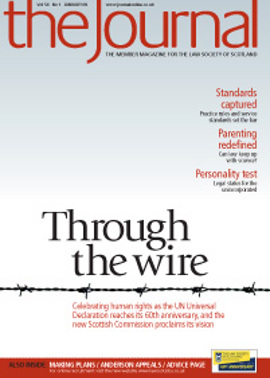Welcome for rejections takeup
This is a follow-up to my article (Journal, March, 17) concerning the number of applications that have to be rejected by RoS at point of receipt. I invited practitioners to contact me to obtain their own firm’s rejection rate.
Many who did, emphasised how useful it was, citing benefits such as measuring quality of their work; reviewing internal systems; reducing re-work, thus increasing efficiency. Some also used the data to work out costs of re-work to their firms in terms of staff time and administration.
I am pleased to report that since March the rejection rate has fallen to 7% of all applications for registration. Our experience shows that rejections arise essentially from administrative oversights.
The main reasons for rejection are:
- application form not submitted; form not signed/questions not answered/wrong form used;
- incorrect or no fee tendered (ros.gov.uk/fees/feescalculator.html);
- incorrect or no SDLT certificate;
- deed inducing registration not submitted; no title number in deed inducing registration (where required).
Requisitions
Acceptance of an application onto the application record only means that it meets basic registration requirements. It is not unusual to discover during title examination that further documentary evidence is needed, or that a deed requires to be returned for amendment. The application is then placed in “standover”: see Land Registration (Scotland) Act 1979, s 4(1) and Land Registration (Scotland) Rules 2006, rule 12.
Last financial year 14% of first registration applications, 8% for transfer of a part, and 9% for dealings with whole, went into standover. Other than a very small number of instances such as subsequent court proceedings or allegations of fraud, standovers should be avoidable if the correct accompanying paperwork is submitted with an application.
The main reasons applications end up in standover are:
- additional deeds have to be requisitioned or deeds returned for amendment;
- we need further plans to plot the property onto the OS map;
- a competing title situation is discovered;
- the application relates in whole or in part to an a non domino title;
- an adverse entry in the register of inhibitions;
- title deeds returned at solicitor’s request.
Every rejection or requisition absorbs additional time and resource in a firm, and increases the burden on our staff. So it is in all our interests to minimise the number of unnecessary instances. We are keen to take any opportunity to make our processes more efficient and effective, so we can pass on savings by reduced cost or improved service, or both.
We have placed on our website (ros.gov.uk/publications/ informationleaflets.html) a checklist covering the main reasons why applications are initially rejected, or we need to request additional information. I encourage you to make your colleagues aware of this and hope it proves a useful aide-mémoire.
You can avoid such problems by using our ARTL system, which self-validates applications for registration to ensure that all necessary information is present before submission. The application will not be rejected because of some oversight in the completion of the application form or through the failure to submit necessary SDLT evidence and the like.
I reiterate my invitation to request your own firm’s rejection rates. I very much welcome feedback on this or any other aspect of our service; such intelligence is extremely valuable in helping us to improve and develop our services.
John Scott, secretary to the Law Society of Scotland’s Conveyancing Committee comments: “It is undoubtedly in the interests of conveyancing firms, as well as the Keeper, to make every effort to ensure that applications are accepted first time round. As well as avoiding the time and effort involved in a correction and resubmission, this reduces the risk of a deed being recorded outwith the 21 day period covered by the selling solicitors’ letter of obligation.”
ARTL UPDATE – as at 19 December
- 12,644 ARTL transactions have taken place.
- 112 solicitors’ firms are currently on the ARTL system.
- 15 lenders are currently on the ARTL system.
- 8 local authorities are using the system.
- 5 full sign-up meetings scheduled for the next four weeks.
For up-to-date information and a full list of participating firms and companies go to: ros.gov.uk/artl/
Stamp Office at home in Queen Street
The move by the HM Revenue and Customs Stamp Office has gone smoothly and the team are now fully operating from Registers of Scotland’s Customer Service Centre in Erskine House, Queen Street, Edinburgh. The Stamp Office team now keeps the RoS Customer Service Centre opening hours of 8.30am-4pm and will no longer close over lunchtime. Contact details can be found on the HMRC website: hmrc.gov.uk .
In this issue
- Public law in Scotland
- Harmony in conflict management
- Tapping Reeve and his legacy
- Busy times at 60
- Living wills - why?
- Forward by the rights
- A cornerstone of rights
- Welcome for rejections takeup
- Sins of omission
- A time to buy?
- Parenthood reborn
- Persons unknown
- Front of the class
- Setting the standards
- Client service: the standards
- Judicial appointments: how you can take part
- ABS - the next phase
- Third parties and premature complaints
- Planning to perform
- Manual for the mind
- Computing on tap - or money down the drain?
- When resolution is not enough
- Ask Ash
- Making up lost time?
- Don't get caught short by transfer traps
- Collaboration: a new dimension
- Packed and ready
- Regulator on a roll
- Scottish Solicitors' Discipline Tribunal
- Website review
- Book reviews
- Medicines: the wrong cure
- Fraud alert! (and a cautionary tale)






